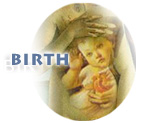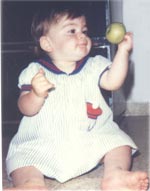|


|
Abraham
made a great feast on the day that Isaac was weaned, and Hannah
offered a prayer of thanksgiving after weaning Samuel, but these
customs never became part of Jewish ritual, although they were practiced
in some communities. An infant was weaned only when he or she was
strong enough to cope with ordinary food, and not if the child was
sickly. When a mother weaned her infant, she often expected an-
other pregnancy soon afterward. Although Sarah was too old to conceive
again, Abraham's feast may have been a celebration of his son's
good health and his ability to leave his mother's arms and spend
time with his father. In contrast, Samuel's weaning meant that Hannah
had to fulfill her promise to dedicate him to lifelong service to
God. She brought Samuel to the priest, uttered her emotional prayer
of thanksgiving and praise to God, and left her son with the priest.
For Hannah, weaning meant more than giving up the warm bodily contact
she had with her son; it meant total separation. |
Until
the middle of the twentieth century, Syrian and Iraqi Jews celebrated
weaning with a large festive party and served wheat cooked in sugar
and cinnamon. Wheat is symbolic of fertility, and the celebration clearly
greeted the possibility of a new pregnancy.[1]
In the early
twentieth century, Jewish mothers in Eastern Europe celebrated weaning
in a different way; the baby's first food was taken from a neighbor.
When the baby accepted the offering, the mother said, "may this
be the last time you will be supported by others." Sometimes a
tiny bag of coins was hung around the baby's neck, symbolizing the receipt
of his last donation.[2]
Infant
survival, contraception, and paternal involvement in child care have
all contributed to make weaning less significant for men than it was
in the past. With nursing no longer a necessity for an infant's survival,
the significance of weaning for a woman has changed, too.
In
recent years, some non-Orthodox Jews have celebrated weaning as a life-cycle
ritual. They have created a new ceremony and have linked it to Abraham's
ancient banquet. This ceremony focuses on the nurturing roles of the
parents and the joys of the child's independence. Some mark the occasion
by giving charity to the hungry.[3]
In
their joyous celebration of these ancient rituals, Jews maintain age-old
traditions to affirm the Jewish identity of newborns and to mark a milestone
in a woman's life cycle. They have found ways of adapting these traditions
to suit modern conditions, for example, by reviving old customs or writing
a new blessing, song, or poem to express the spirituality a parent may
feel on the occasion of the ceremony. Secular Jews who find no meaning
in such ceremonies may nevertheless perform a non-religious circumcision.
Although Orthodox Jews continue to redeem their firstborn sons and to
observe the biblical laws regarding a woman's purity, secular Jews often
do not know of these duties or have consciously rejected them. As modern
Jews rediscover their roots, some are now finding joy and meaning in
these old traditions.
 |
[1]
Dr. Y. Latti, personal communication. [back]
[2]
Schauss H. The Lifetime of a Jew (New York:
Union of American Hebrew Congregations, 1950), pp. 81. Sephardic,
North African and Asian Jews do not celebrate this event, which
would often be helped by annointing the breast with an unpleasant-tasting
substance that the infant would be sure to reject. [back]
 [3]
Strassfeld, Sharon and Michael Strassfeld, eds.
The Second Jewish Catalogue (Philadelphia: Jewish Publication
Society of America, 1976), pp. 43-45. See also Anita Diamant,
The New Jewish Baby Book: Names, Ceremonies & Customs: A Guide
for Today's Families (Woodstock, Vermont: Jewish Lights Publishing,
1994) and Schneider, S.W, Jewish and Female (New York:
Touchstone [Simon and Schuster], 1985. [back] [3]
Strassfeld, Sharon and Michael Strassfeld, eds.
The Second Jewish Catalogue (Philadelphia: Jewish Publication
Society of America, 1976), pp. 43-45. See also Anita Diamant,
The New Jewish Baby Book: Names, Ceremonies & Customs: A Guide
for Today's Families (Woodstock, Vermont: Jewish Lights Publishing,
1994) and Schneider, S.W, Jewish and Female (New York:
Touchstone [Simon and Schuster], 1985. [back]
|
 |
 From:
Michele Klein, A Time to be Born: Customs and Folklore of Jewish
Birth. © copyright 1998 by Michele Klein (Philadelphia: Jewish
Publication Society of America), pp. 195-96. Permission of the
author and Jewish Publication Society of America. From:
Michele Klein, A Time to be Born: Customs and Folklore of Jewish
Birth. © copyright 1998 by Michele Klein (Philadelphia: Jewish
Publication Society of America), pp. 195-96. Permission of the
author and Jewish Publication Society of America.
|
|



